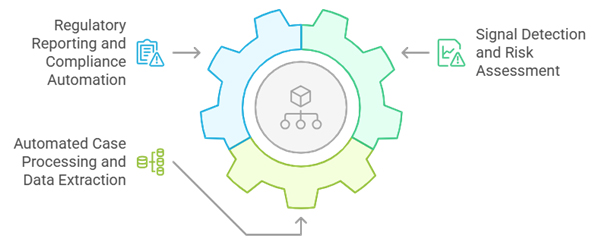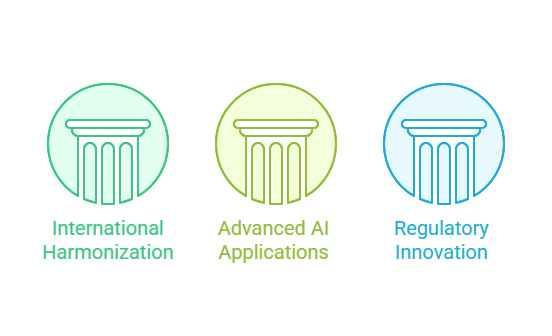
The pharmaceutical industry is witnessing a transformative shift as artificial intelligence (AI) becomes increasingly integrated into drug safety monitoring and pharmacovigilance (PV) processes. In 2024 and early 2025, major regulatory bodies including the European Medicines Agency (EMA), the U.S. Food and Drug Administration (FDA), and the International Council for Harmonisation (ICH) have released comprehensive guidelines addressing AI implementation in pharmacovigilance systems.
These developments represent a critical milestone for pharmaceutical companies, regulatory professionals, and safety experts who are navigating the complex landscape of AI-driven drug safety monitoring. As adverse event reporting volumes continue to surge and data complexity increases, AI technologies promise to enhance signal detection, automate case processing, and improve overall pharmacovigilance efficiency.
This blog provides a comprehensive overview of the latest regulatory guidance from these key authorities, examining how AI is reshaping pharmacovigilance practices and what pharmaceutical industry professionals need to know to ensure compliance while maximizing the benefits of these powerful technologies.
The European Medicines Agency has taken a proactive stance on AI integration within pharmacovigilance systems. In March 2024, the EMA introduced the Scientific Explorer, an AI-enabled knowledge mining tool designed to help EU regulators conduct focused searches of regulatory scientific information. This tool represents a concrete example of how the agency is leveraging AI to improve data efficiency and decision-making processes.
The EMA’s artificial intelligence workplan, outlined in their strategic framework, emphasizes the need for robust validation, transparency, and continuous monitoring of AI systems throughout the medicinal product lifecycle. The agency has established clear expectations that marketing authorization applicants and holders must implement mechanisms ensuring AI and machine learning systems are transparent, accessible, validated, and continuously monitored.
Key aspects of EMA’s approach include:

In January 2025, the FDA released its draft guidance document titled “Considerations for the Use of Artificial Intelligence To Support Regulatory Decision-Making for Drug and Biological Products.” This guidance provides a risk-based credibility assessment framework specifically designed for evaluating AI models used in regulatory submissions.
The FDA’s approach centers on establishing credibility assessments that consider the context of use (COU) for specific AI applications. This framework is particularly relevant for pharmacovigilance applications where AI systems are used to:
The FDA emphasizes that sponsors must demonstrate the reliability, validity, and clinical relevance of AI systems before implementation in safety-critical applications. This includes comprehensive validation studies, ongoing performance monitoring, and clear documentation of AI system limitations.
While the ICH has not yet released specific guidelines dedicated to AI in pharmacovigilance, the organization is actively working on harmonizing international approaches to AI regulation in pharmaceutical development and safety monitoring. The ICH’s current focus areas include:
The Council for International Organizations of Medical Sciences (CIOMS) has also contributed to this landscape through its Working Group XIV report on artificial intelligence in pharmacovigilance, which is currently under public consultation through June 2025.

Modern pharmacovigilance systems process millions of adverse event reports annually, creating significant challenges for manual case processing. AI technologies are revolutionizing this area through:
Natural Language Processing (NLP) Applications:
Machine Learning for Case Classification:
Real-world implementation examples include pharmaceutical companies using AI to reduce case processing time by 60-70% while maintaining high accuracy rates in medical information extraction. These systems can process complex medical narratives, identify key safety information, and populate structured databases with minimal human intervention.
AI-powered signal detection represents one of the most promising applications in pharmacovigilance, offering capabilities that far exceed traditional statistical methods:
Advanced Pattern Recognition:
Predictive Analytics for Risk Assessment:
Real-time Monitoring Capabilities:
AI systems are increasingly being deployed to streamline regulatory reporting processes and ensure compliance with evolving safety requirements:
Automated Report Generation:
Compliance Monitoring Systems:
Implementing AI in pharmacovigilance presents significant challenges related to data quality and system validation. Regulatory authorities emphasize several critical considerations:
Data Integrity and Standardization:
Model Validation and Performance Monitoring:
Transparency and Explainability Requirements:
Regulatory guidelines consistently emphasize the critical importance of maintaining human oversight in AI-driven pharmacovigilance systems. This includes:
Qualified Person Responsibilities:
Governance and Quality Management:
The implementation of AI in pharmacovigilance requires careful attention to regulatory compliance and documentation requirements:
Pharmacovigilance System Master File (PSMF) Updates:
Regulatory Submission Requirements:
The regulatory landscape for AI in pharmacovigilance continues to evolve rapidly, with several key trends emerging:

Increased International Harmonization:
Advanced AI Applications:
Regulatory Innovation:
Pharmaceutical companies should consider several strategic factors when preparing for AI implementation in pharmacovigilance:
Technology Infrastructure:
Regulatory Strategy:
As artificial intelligence reshapes the landscape of pharmacovigilance, regulatory bodies like the EMA, FDA, and ICH are taking decisive steps to provide structured guidance, promote transparency, and ensure patient safety. These evolving frameworks underscore the need for pharmaceutical companies to strike a balance between innovation and compliance.
By embracing AI technologies—such as NLP, machine learning, and real-time monitoring tools—organizations can dramatically enhance the efficiency, accuracy, and responsiveness of their drug safety operations. However, successful implementation demands rigorous validation, robust governance, continuous oversight, and strategic alignment with emerging regulatory expectations.
For pharma leaders and regulatory professionals, staying ahead of these developments is not just a matter of compliance, but a strategic imperative to future-proof pharmacovigilance systems and ensure safe, effective treatments in an increasingly data-driven world.